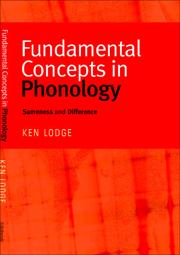Book contents
5 - Phonetic implementation and abstractness
Published online by Cambridge University Press: 05 August 2013
Summary
The phonetic interpretation of phonological categories is context dependent …
(Pierrehumbert, Phonological and phonetic representation)Introduction
The issue of the abstractness of phonological representations seems to be consistently avoided in the literature generally. There is an assumption in many papers that phonetic implementation is not a problem and it is, therefore, not addressed. (This is instanced in the many contributions to Goldsmith, 1995, some of which I have already referred to in the previous chapters; this collection of papers has been chosen for particular scrutiny, firstly because I reviewed it some time ago, Lodge, 1997, and secondly it was intended to be a collection of up-to-date seminal papers on phonological theory.) On the other hand, there are specific references to the matter; for example, Harris & Lindsey (1995) and Spencer (1996: 141-4), though in both cases it is assumed that phonological elements should have a direct and seminal phonetic interpretation. In a footnote Clements & Hume point out that their place features ‘labial, coronal and dorsal have specific phonetic correlates just as other features do’ (1995: 301). These are listed in the text (Clements & Hume 1995: 252 (7) and, revised to include vowels, 277 (41)), as follows:
Labial: involving the lips as an active articulator
Coronal: involving the tongue front as active articulator
Dorsal: involving the tongue body as active articulator
Phonological features therefore have phonetic content.
- Type
- Chapter
- Information
- Fundamental Concepts in PhonologySameness and Difference, pp. 65 - 93Publisher: Edinburgh University PressPrint publication year: 2009



